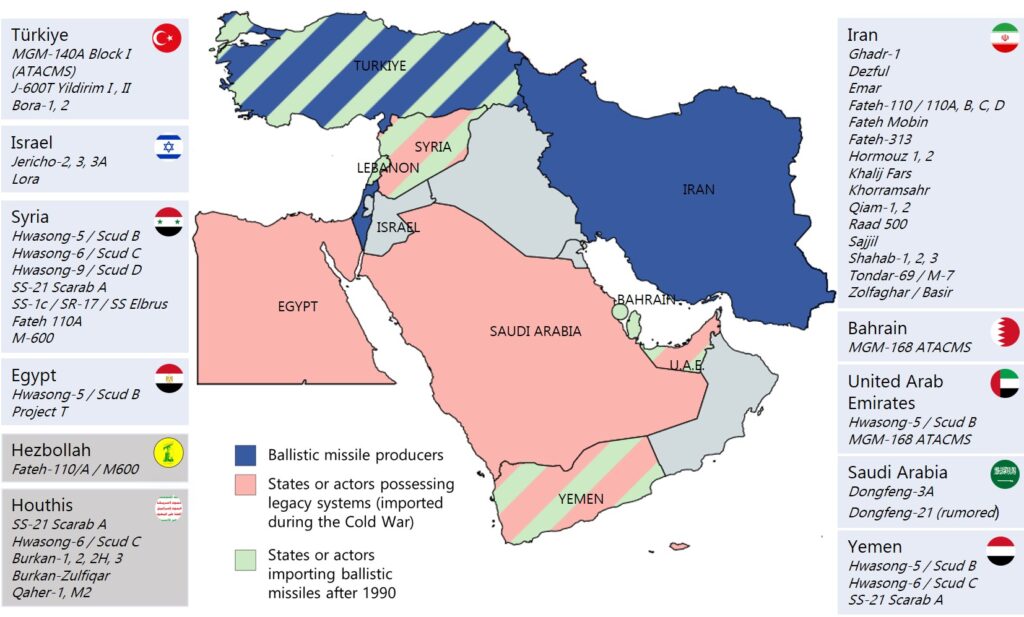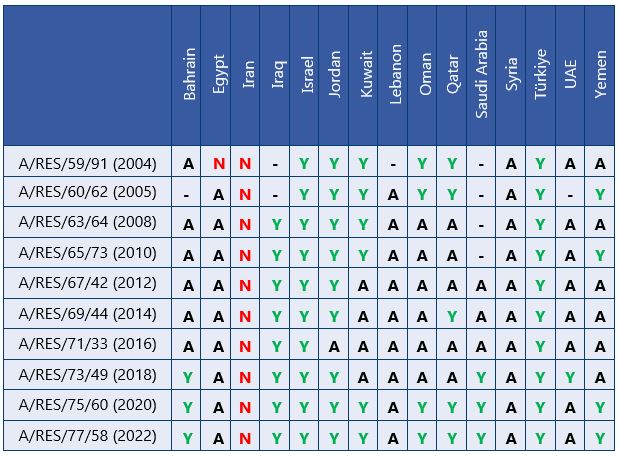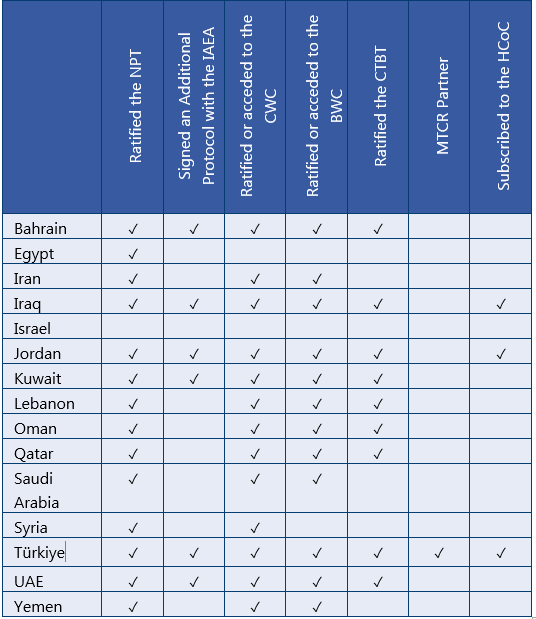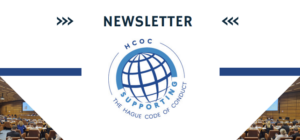The Hague Code of Conduct
in the Middle East
HCoC Issue Brief – March 2022
About the Hague Code of Conduct
Adopted in 2002, the Hague Code of Conduct against Ballistic Missile Proliferation (HCoC) is a politically binding instrument aiming to limit the proliferation of weapons of mass destruction (WMD) delivery vehicles. Composed of a set of transparency and confidence-building measures, the HCoC is the only existing multilateral instrument that focuses on WMD delivery vehicles. The HCoC has reached 143 subscribing states (December 2022) vs 93 at its inception.
When subscribing to the HCoC, states commit to abide by a set of United Nations (UN) treaties and international conventions on space security; to produce an annual declaration regarding ballistic missile capacities and national policy on non-proliferation and disarmament treaties and instruments; and to deliver pre-launch notifications prior to any missile or space launch. Documents are uploaded onto a dedicated online platform managed by Austria, which acts as the HCoC Immediate Central Contact (Executive Secretariat). Subscription to the HCoC is free of charge.
While subscribing states are asked to exercise ‘maximum restraint’ in the development of ballistic capacities, they are proscribed neither from possessing ballistic missiles nor from pursuing space launch activities. In return, subscribing to the HCoC enables states to gain access to information shared by other subscribing states, and to display their political commitment to non-proliferation and disarmament.
In brief
The HCoC holds special significance in the Middle East as the region is fraught with the development of ballistic arsenals, the use of missiles on the battlefield and the proliferation of such systems towards both states and non-state actors. Moreover, several ballistic missile programmes have been closely associated with WMD acquisition.
However, the Middle East only counts three HCoC subscribing states (Iraq, Jordan and Türkiye). A number of political and strategic factors impede wider HCoC subscription in the region, as well as preventing progress on other non-proliferation agreements.
The logic of a politically-binding Code of conduct could nevertheless serve as a first step to bolster confidence between regional actors and work towards a more elaborate arms controls regime in the region.
Author: Lauriane Héau and Emmanuelle Maitre
Ballistic missiles in the Middle East: a widespread weapon
The Middle East1 is the region with the highest density of ballistic missile possessor states. Moreover, some non-state actors have also acquired systems recent or ongoing conflicts. While regional missile competition is not new, it has intensified in recent years – and the number of strikes has also increased.2
Ballistic missile arsenals in the region can be split in different categories (Figure 1). Firstly, Israel is a unique case as it developed ballistic missile capabilities predominantly to serve as delivery vehicles for its un-official nuclear arsenal. The Jericho is therefore dedicated to the nuclear deterrent, although shorter-range ballistic missiles may be used in a conventional role. In addition, at least three countries have become missile producers in their own right. Iran and Iraq both launched their programmes during the Iran-Iraq war in the 1980s. While Iraq was forced to halt production with the fall of Saddam Hussein, Iran remains active in developing a wide array of ballistic missiles. Türkiye also has a domestic production capacity which enabled it to develop two kinds of indigenous short and medium-range missiles. Thirdly, a number of countries continue to operate older missiles imported during the Cold War, especially Scud derivatives. These systems may have been linked to WMD programmes (Egypt, Syria) but have also been deployed as a conventional deterrent (UAE, Yemen). Some countries are also acquiring ballistic missiles from foreign providers. Within the limitations imposed by the Missile Technology Control Regime (MTCR), the United States has sold MGM-140A Block I (ATACMS) systems to Türkiye, Bahrain and the UAE.3 Finally, non-declared transfers may have also taken place, notably from Iran to Syria, from North Korea to Syria and from China to Saudi Arabia.4

Proliferation networks of concern
Meanwhile, some states and non-state actors in the region have also acquired ballistic missile technology through active proliferation networks. As long-distance transfers have become increasingly difficult given the risk of detection and interception by maritime patrols, regional exchanges are privileged. The Iran-Syria axis has been very active in recent years, a decade after the first sales of ballistic missile-related materials and technologies from North Korea. Missile technology transfers from Iran have reportedly enabled Syria to produce its own version of the Fateh-110A since 2008. Moreover, non-state actors are increasingly becoming recipients – and end-users – of clandestine transfers of ballistic missile-related materials and technologies. This may be the case of the Hezbollah, which has reportedly received different weapon systems (Scud B, C or D, Fateh-100A or Zelzal) from Syria as well as from Iran.5 It is also the case of the Houthis, which after operating legacy weapons stockpiled by Yemen since the 1990s, have been using Burkan 1 and 2 (since 2017) in the Yemen war. These weapons appear to be of Iranian origin and derived from the Qiam-1.6
HCoC subscription and implementation in the region
The Middle East is one of the regions with the lowest HCoC subscription rates, with only three subscribing states, namely Jordan (2002), Türkiye (2002) and Iraq (2010). This rate is especially significant since almost all states have ballistic systems in their arsenals. Some in the region have voiced criticism about the HCoC publicly.7 In this context, it is not surprising that the resolutions adopted by the UN General Assembly (UNGA) to support the HCoC have only garnered modest support until recently, with a majority of states abstaining (Figure 2). Since 2018 however, an increasing number of states have voted in favour of the resolutions. In the latest vote (December 2020), Kuwait, Oman and Qatar approved the resolution for the first time, bringing the total to ten out of fifteen Middle Eastern states voting in favour. This may signal a shift towards a less critical perception of the HCoC in the region.

Challenges for HCoC in the Middle East

There are several challenges to improving the level of subscription to the HCoC in the Middle East. Firstly, as ballistic systems have been used very recently by states (Iranian strikes on the territory of Iraq, January 2020) and non-state actors (Houthi strikes on Saudi Arabia, Yemen and the United Arab Emirates) for conventional purposes. In this regard, CBMs may seem somewhat irrelevant to address the risks posed by these systems. Indeed, the HCoC was mostly conceived as a tool to limit the danger of ballistic systems used for the delivery of WMD. The transparency measures are framed for missiles used and tested within national nuclear deterrence strategies; they have little value for conventional systems used on the battlefield.8 Typically, pre-launch notifications are irrelevant when it comes to striking enemy targets.
Iran’s fast-improving missile arsenal is also seen as a factor of tension. The adoption of the Joint Comprehensive Plan of Action (JCPOA) in 2015 initially alleviated concerns regarding Iran’s missile programme by limiting the risk of any association to nuclear weapons. Moreover, UN Security Council Resolution 2231 which was adopted alongside the JCPOA, retained the existing sanctions on Iran’s ballistic missile programme.
But following the US withdrawal from the agreement in 2018, tensions increased once again. Restoring the agreement – or agreeing on restrictions on the development of ballistic missiles – would serve to reinforce mutual trust and security in the region.
Secondly, at the political level, the Middle East is a region where a number of non-proliferation norms have yet to achieve universalisation (Figure 3). This is particularly due to the fact that one state (Israel) has developed a nuclear deterrent outside of the Nuclear Non-Proliferation Treaty (NPT) and that many states have since proliferated WMD illegally. WMD have also been used on a wide scale across the region, with chemical attacks in Yemen in 1963, during the 1980-1988 Iran-Iraq war, in Iraq in the 1990s against the Kurds and repeatedly during the recent Syrian civil war.
Political tensions continue to slow down progress on most non-proliferation instruments: Egypt conditions its adherence to many instruments on progress towards the creation of a Middle East nuclear-free zone implying the denuclearisation of Israel, while Israel refuses to join instruments as long as some neighbouring states pursue WMD programmes. In the nuclear realm, only six states have ratified an IAEA Additional Protocol. As for other non-proliferation instruments, most states are waiting for their neighbours to take the first step or would prefer a regional approach.

HCoC subscription: what benefits for Middle Eastern states
Despite these challenges, HCoC universalisation in the Middle East could be an effective step forward. As a CBM, it could be easier for states to commit to the Code’s political commitments than to legally-binding treaties and agreements. The model of the HCoC, with its limited obligations and pragmatic focus, can also serve as a model for regional instruments on other security issues in the Middle East.
Additionally, given that ballistic arsenals remain highly active in the region and many states have ambitious plans for space exploration, clarifying the peaceful nature of space launch vehicles and diminishing the risk of misunderstanding linked to ballistic missiles would be a particularly useful measure. Two regional states already have space launch capabilities (Israel and Iran), and the Iranian programme in particular is often linked to military activities.9 Half a dozen regional states already produce their own satellites and the emergence of CubeSats has led to innovative programmes led by space newcomers such as Jordan or Iraq (Figure 4). Finally, some states are currently leading flagship space programmes, such as the UAE which launched a mission to Mars in July 2020.

1 In this paper, the Middle East region is defined as composed of Bahrain, Egypt, Iran, Iraq, Israel, Jordan, Kuwait, Lebanon, Oman, Qatar, Saudi Arabia, Syria, Türkiye, the United Arab Emirates, and Yemen.
2 Tytti Erästö & Pieter D. Wezeman, ‘Addressing Missile Threats in the Middle East and North Africa’, SIPRI Policy Brief, November 2020.
3 ‘Chapter 7: Middle East and North Africa,’ The Military Balance, IISS, February 2021.
4 ‘Syria,’ NTI, updated in March 2021, https://www.nti.org/learn/countries/syria/ ; ‘Iran,’ NTI, updated in April 2021, https://www.nti.org/learn/countries/iran/ ; and ‘Saudi Arabia,’ NTI, updated in June 2019 March 2021, , https://www.nti.org/learn/countries/saudi-arabia/
5 Shaan Shaikh, ‘Missiles and Rockets of Hezbollah’, Missile Threat, CSIS, June 26, 2018, last modified September 27, 2019, https://missilethreat.csis.org/country/hezbollahs-rocket-arsenal.
6 Jean Masson, ‘Les missiles des Houthis: prolifération balistique et groupes armés non-étatiques,’ Recherches & Documents, FRS, December 2018.
7 ‘Hague Code of Conduct Against Ballistic Missile Proliferation Welcomed in Text Approved by Disarmament Committee,’ GA/DIS/3286, United Nations, 26 October 2004.
8 Stéphane Delory, ‘Ballistic missiles and conventional strike weapons: Adapting the HCoC to address the dissemination of conventional ballistic missiles,’ HCoC Research Paper, no. 6, January 2020.
9 Florence Gaillard-Sborowsky, ‘Prolifération spatiale versus dissémination en matière spatiale : des enjeux sémantiques aux enjeux politiques,’ Note de la FRS, n°18/2015, September 2015.



